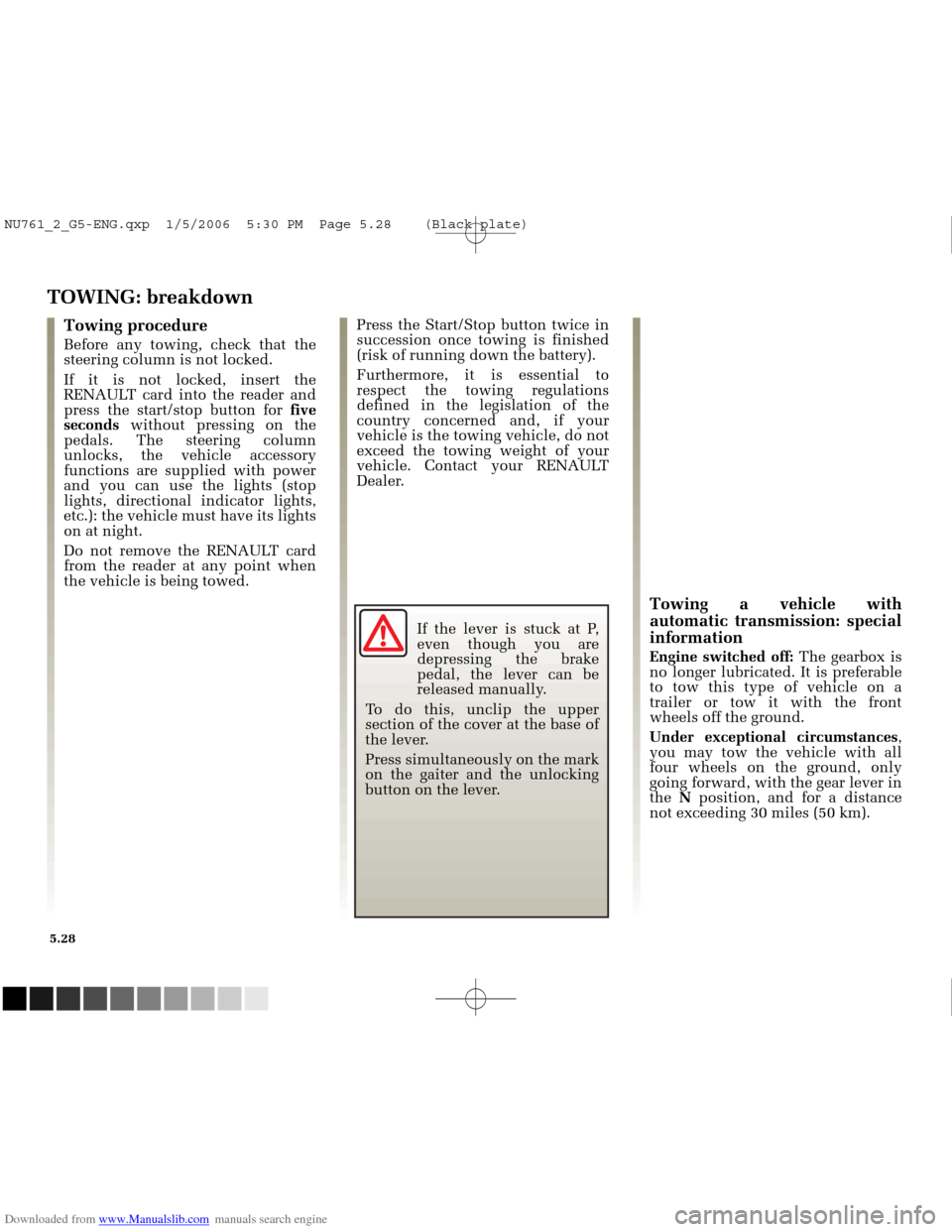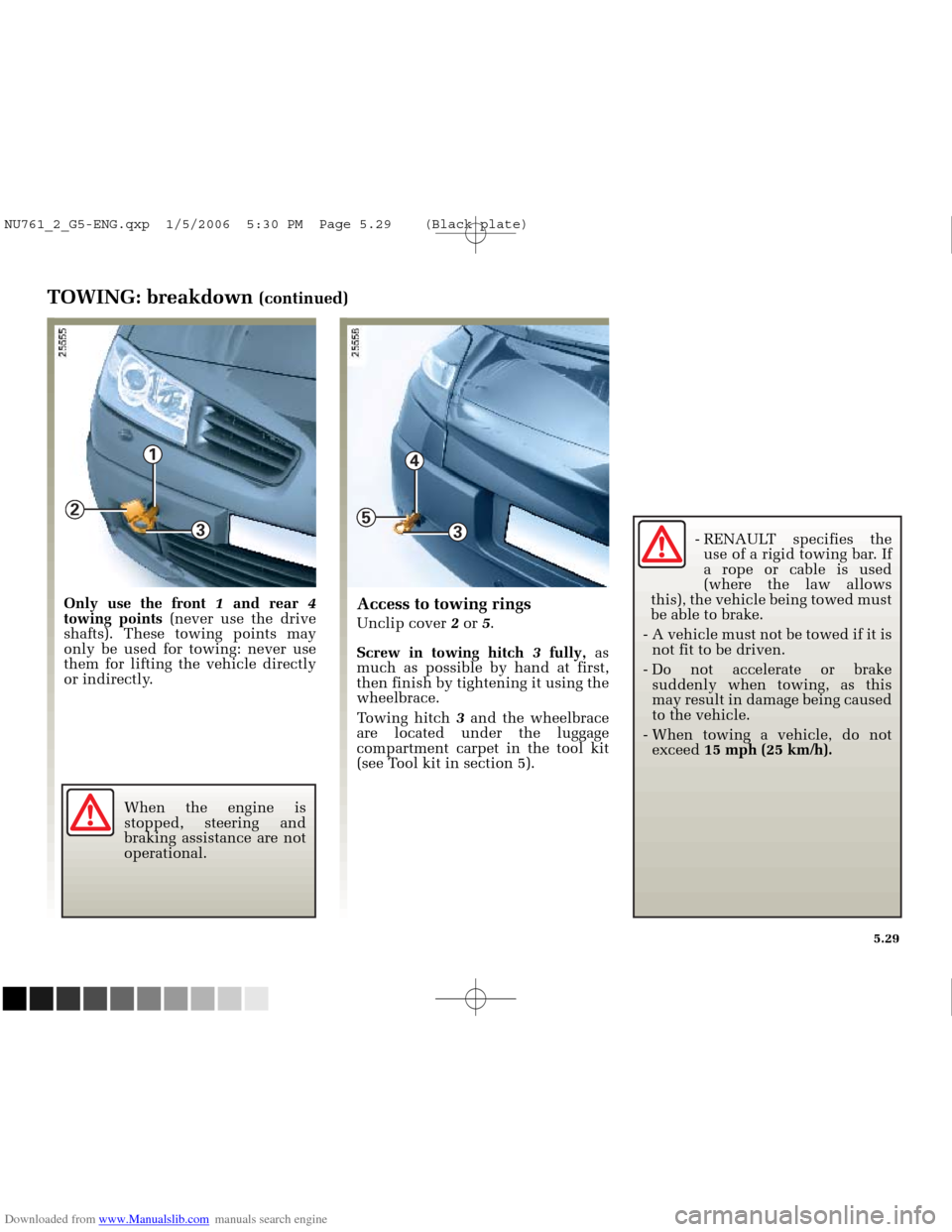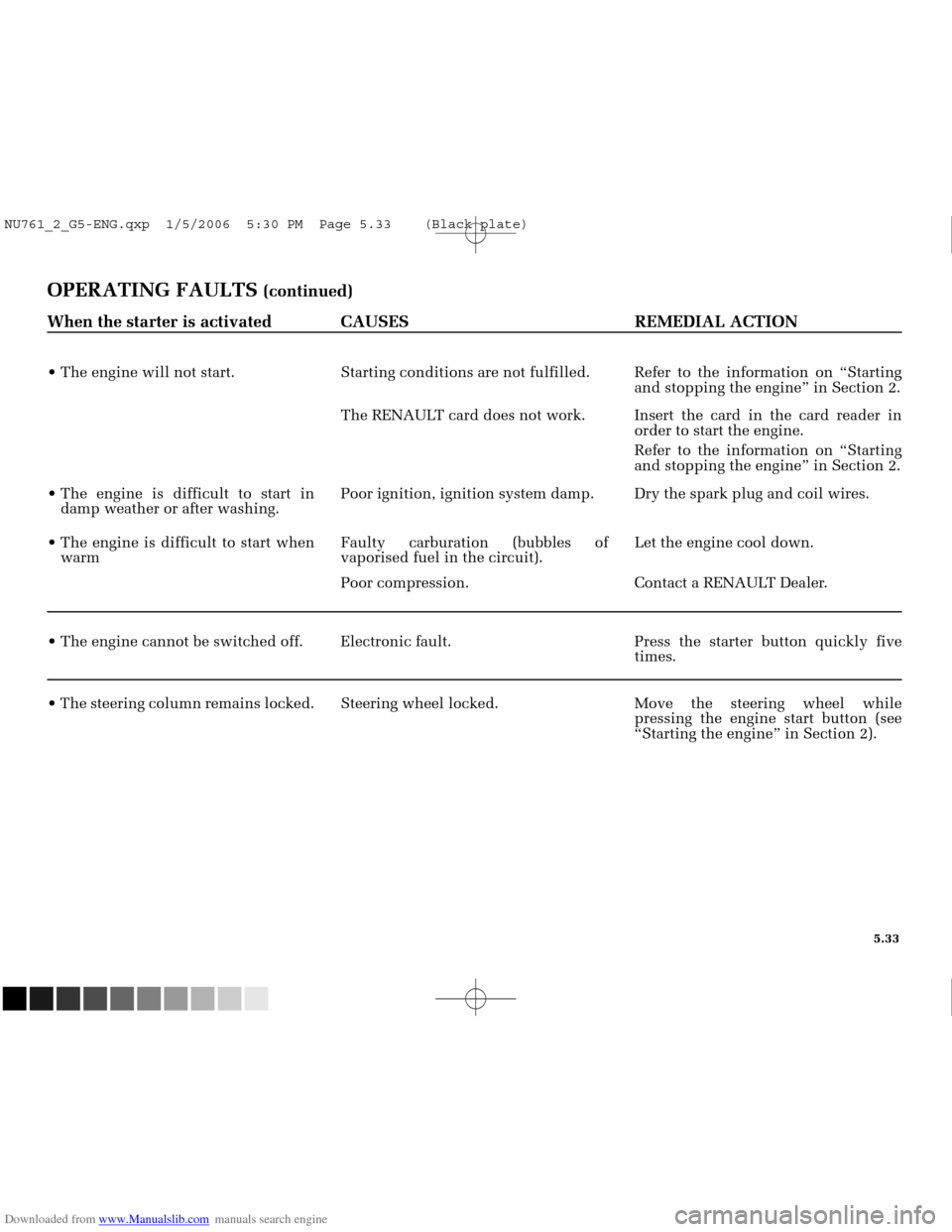2005 RENAULT MEGANE steering
[x] Cancel search: steeringPage 195 of 250

Downloaded from www.Manualslib.com manuals search engine
NU761_2_G5-FRA.qxd 4/11/05 11:09 Page 5.07
5.07
TYRES (continued)
Pressures should be checked when
the tyres are cold; ignore higher
pressures which may be reached in
hot weather or following a fast
journey.
If the tyre pressures cannot be
checked when the tyres are cold,
assume an increase of 0.2 to 0.3 bar
(or 3 psi. ).
Never deflate a hot tyre.
Note: a label (depending on country
or model) fixed to the edge or frame
of the driver’s door gives the
recommended tyre pressures.
Changing wheels around
This practice is not recommended.
Tyre pressures
Tyre pressures must be adhered to,
tyre pressures for all wheels
(including the spare wheel) must be
checked at least once a month and
always before a long journey (refer
to the information on Tyre
pressures).
Emergency spare wheel
Refer to the information relating to
the emergency spare wheel and
changing a wheel in Section 5.
Fitting new tyres
Incorrect tyre pressures
lead to abnormal tyre
wear and unusually hot
running, factors which
may seriously affect safety and
lead to:
- poor roadholding,
- the risk of blow-outs or of throwing a tread at high speed.
The pressure depends on the load
and the speed of use. Adjust the
pressures according to the
conditions of use (refer to the
information on Tyre pressures). Vehicles equipped with
the tyre pressure monitor
Each of the sensors fitted
in the valves is dedicated
to one particular wheel: the
wheels must therefore not be
swapped around.
There is a risk of incorrect
information which could have
serious consequences. For safety reasons, this
operation must be carried
out by a specialist.
Fitting different tyres may
change your vehicle as follows:
- It may mean that your vehicle no longer conforms to current
regulations.
- It may change the way it handles when cornering.
- It may cause the steering to be heavy.
- It may cause tyre noise.
- It may affect the use of snow chains.
NU761_2_G5-ENG.qxp 1/5/2006 5:30 PM Page 5.07 (Black plate)
Page 206 of 250

Downloaded from www.Manualslib.com manuals search engine
1
3
2
1
2
NU761_2_G5-FRA.qxd 4/11/05 11:09 Page 5.18
5.18
FUSES
Fuse box 1
If electrical equipment does not
work, check the condition of the
fuses.
Open cover 2(underneath the
steering wheel or inside the glove
box).
To identify the fuses, refer to the
fuse allocation sticker (shown on the
following page).
In accordance with local
legislation or as a precautionary
measure:
Obtain an emergency kit of spare
bulbs and fuses from your
RENAULT Dealer.
Take out the fuse using tweezers 3,
located on the cover 2.
To remove the fuse from the
tweezers, slide the fuse to the side.
It is not advisable to use the free fuse
locations.
CORRECT INCORRECT
Check the fuse in question
and, if necessary, replace it
with a fuse of the same
rating.
If you fit a higher-amp fuse, it may
cause the electrical circuit to
overheat (risk of fire) in the event of
a consumer drawing an excessive
current.
NU761_2_G5-ENG.qxp 1/5/2006 5:30 PM Page 5.18 (Black plate)
Page 216 of 250

Downloaded from www.Manualslib.com manuals search engine
NU761_2_G5-FRA.qxd 4/11/05 11:10 Page 5.28
5.28
TOWING: breakdown
Press the Start/Stop button twice in
succession once towing is finished
(risk of running down the battery).
Furthermore, it is essential to
respect the towing regulations
defined in the legislation of the
country concerned and, if your
vehicle is the towing vehicle, do not
exceed the towing weight of your
vehicle. Contact your RENAULT
Dealer.Towing procedure
Before any towing, check that the
steering column is not locked.
If it is not locked, insert the
RENAULT card into the reader and
press the start/stop button for five
seconds without pressing on the
pedals. The steering column
unlocks, the vehicle accessory
functions are supplied with power
and you can use the lights (stop
lights, directional indicator lights,
etc.): the vehicle must have its lights
on at night.
Do not remove the RENAULT card
from the reader at any point when
the vehicle is being towed.
Towing a vehicle with
automatic transmission: special
information
Engine switched off: The gearbox is
no longer lubricated. It is preferable
to tow this type of vehicle on a
trailer or tow it with the front
wheels off the ground.
Under exceptional circumstances ,
you may tow the vehicle with all
four wheels on the ground, only
going forward, with the gear lever in
the N position, and for a distance
not exceeding 30 miles (50 km).
If the lever is stuck at P,
even though you are
depressing the brake
pedal, the lever can be
released manually.
To do this, unclip the upper
section of the cover at the base of
the lever.
Press simultaneously on the mark
on the gaiter and the unlocking
button on the lever.
NU761_2_G5-ENG.qxp 1/5/2006 5:30 PM Page 5.28 (Black plate)
Page 217 of 250

Downloaded from www.Manualslib.com manuals search engine
3
1
2
3
4
5
NU761_2_G5-FRA.qxd 4/11/05 11:10 Page 5.29
5.29
TOWING: breakdown (continued)
Only use the front 1and rear 4
towing points (never use the drive
shafts). These towing points may
only be used for towing: never use
them for lifting the vehicle directly
or indirectly.Access to towing rings
Unclip cover 2or 5.
Screw in towing hitch 3fully, as
much as possible by hand at first,
then finish by tightening it using the
wheelbrace.
Towing hitch 3and the wheelbrace
are located under the luggage
compartment carpet in the tool kit
(see Tool kit in section 5).
When the engine is
stopped, steering and
braking assistance are not
operational. - RENAULT specifies the
use of a rigid towing bar. If
a rope or cable is used
(where the law allows
this), the vehicle being towed must
be able to brake.
- A vehicle must not be towed if it is not fit to be driven.
- Do not accelerate or brake suddenly when towing, as this
may result in damage being caused
to the vehicle.
- When towing a vehicle, do not exceed 15 mph (25 km/h).
NU761_2_G5-ENG.qxp 1/5/2006 5:30 PM Page 5.29 (Black plate)
Page 220 of 250

Downloaded from www.Manualslib.com manuals search engine
NU761_2_G5-FRA.qxd 4/11/05 11:10 Page 5.32
OPERATING FAULTS (continued)
When the starter is activated CAUSES REMEDIAL ACTION
There is no response, the indicator lights fail to light up and the starter
does not turn. Battery lead disconnected or terminals
oxidised.
Check battery terminals: scrape and
clean if oxidised and re-tighten.
Discharged battery. Connect another battery to the faulty battery.
Battery unserviceable. Replace battery. Do not push the vehicle if the steering
column is locked.
Warning light bulbs go dim and starter turns very slowly. Battery terminals not tight, battery
terminals oxidised. Check battery terminals: scrape and
clean if oxidised and re-tighten.
Discharged battery. Connect another battery to the faulty battery.
5.32
NU761_2_G5-ENG.qxp 1/5/2006 5:30 PM Page 5.32 (Black plate)
Page 221 of 250

Downloaded from www.Manualslib.com manuals search engine
NU761_2_G5-FRA.qxd 4/11/05 11:10 Page 5.33
5.33
OPERATING FAULTS (continued)
When the starter is activated CAUSES REMEDIAL ACTION
The engine will not start. Starting conditions are not fulfilled. Refer to the information on “Starting and stopping the engine” in Section 2.
The RENAULT card does not work. Insert the card in the card reader in order to start the engine.
Refer to the information on “Starting
and stopping the engine” in Section 2.
The engine is difficult to start in damp weather or after washing. Poor ignition, ignition system damp. Dry the spark plug and coil wires.
The engine is difficult to start when warm Faulty carburation (bubbles of
vaporised fuel in the circuit). Let the engine cool down.
Poor compression. Contact a RENAULT Dealer.
The engine cannot be switched off. Electronic fault. Press the starter button quickly five times.
The steering column remains locked. Steering wheel locked. Move the steering wheel while pressing the engine start button (see
“Starting the engine” in Section 2).
NU761_2_G5-ENG.qxp 1/5/2006 5:30 PM Page 5.33 (Black plate)
Page 224 of 250

Downloaded from www.Manualslib.com manuals search engine
NU761_2_G5-FRA.qxd 4/11/05 11:10 Page 5.36
5.36
OPERATING FAULTS (continued)
On the open road CAUSES REMEDIAL ACTION
- weak or dead battery. Recharge or replace the battery.
Steering wheel hard to turn: - assistance overheating, Leave to cool.
The engine overheats. The coolant
temperature warning light comes on
(or the indicator needle is in the red
area). Coolant pump: belt stretched or
broken.
Engine cooling fan not working.
Stop the vehicle and switch off the
engine. Contact a RENAULT Dealer.
Coolant leaks. Check the condition of hoses and clips.
Check the expansion bottle: it should
contain coolant. If it does not, top it up
(once it has cooled). Take care not to
scald yourself. This action is only
temporary: contact your RENAULT
Dealer as soon as possible.
Radiator: never fill a hot radiator with cold coolant if a considerable quantity h\
as been lost. After any operation
on the vehicle which has involved even partial draining of the cooling s\
ystem, it must be refilled with a new
mixture prepared in the correct proportions. Reminder: only products app\
roved by RENAULT’s Technical
Department may be used for this purpose.
NU761_2_G5-ENG.qxp 1/5/2006 5:30 PM Page 5.36 (Black plate)
Page 247 of 250

Downloaded from www.Manualslib.com manuals search engine
NU761_2_G6-FRA.qxd 4/11/05 11:11 Page 6.21
ALPHABETICAL INDEX
FFront seat belt pretensioners ..................................... 1.25 - 1.29
Front seats (adjustment) .......................................... 1.19 ➟ 1.20
Fuel (economy) ........................................................ 2.11 ➟ 2.13
Fuel (filling) ............................................................... 1.89 - 1.90
Fuel (grade) ................................................................ 1.89 - 1.90
Fuel level ................................................................. 1.48 ➟ 1.77
Fuel tank capacity ..................................................... 1.89 - 1.90
Fuses ........................................................................\
.. 5.18 - 5.19
G Gear lever ........................................................................\
..... 2.09
Glove box ................................................................. 3.25 ➟ 3.28
H Hand brake ........................................................................\
... 2.10
Hazard warning lights ......................................................... 1.81
Head restraints ........................................................... 1.17 - 1.18
Headlight beam adjustment ................................................ 1.85
Headlights .............................................................\
... 5.09 ➟ 5.12
Heated seats ........................................................................\
. 1.20
Heating ................................................................\
..... 3.04 ➟ 3.16
Hubcap tool ........................................................................\
.. 5.03
I Ignition switch ........................................................... 2.03 - 2.05
Indicators ......................................................... 1.81 - 5.10 - 5.13
Indicators:
direction indicators ......................................................... 1.82
instrument panel ..................................................... 1.48 ➟ 1.77
Information display ............................................................. 1.61
Instrument panel ..................................................... 1.48 ➟ 1.77
J Jack ...................................................................\
.................... 5.03
L Levels .................................................................\
...... 4.04 ➟ 4.10
Lifting the vehicle (changing a wheel) ............................... 5.05
Lighting: exterior ...............................................................\
.. 1.82 ➟ 1.84
instrument panel .............................................................. 1.82
interior ....................................................... 3.24 - 5.15 ➟ 5.17
see-me-home ............................................................\
........ 1.83 L
Lights:
adjusting ..............................................................\
............. 1.85
brake lights ............................................................. 5.13 - 5.14
dipped beam headlights ............................ 1.82 - 5.09 ➟ 5.11
direction Indicators ......................... 1.81 - 5.09 ➟ 5.11 - 5.14
fog lights ...................................................... 1.84 - 5.12 - 5.13
hazard warning lights ...................................................... 1.81
main beam headlights ................................. 1.83 - 5.09 - 5.10
registration plate lights .................................................... 5.14
reversing lights ................................................................. 5.13
side lights ................................................... 1.82 - 5.09 ➟ 5.13
Locking the doors .................................................... 1.02 ➟ 1.14
Luggage compartment ............................................. 3.31 ➟ 3.34
M Maintenance:
bodywork ............................................................... 4.12 - 4.13
interior trim ...................................................................... 4.14
mechanical .............................................................\
.. 4.04 ➟ 4.11
Map reading lights ............................................................... 3.24
Methods of restraint in addition to seat belts ........................................................... 1.25 ➟ 1.31
O Operating faults ....................................................... 5.31 ➟ 5.38
P Paintwork (maintenance) .......................................... 4.12 - 4.13
Paintwork (reference) .......................................................... 6.02
Parking proximity sensor .......................................... 2.32 - 2.33
Power assisted steering ....................................................... 2.10
Practical advice ........................................................ 2.11 ➟ 2.13
Puncture ...............................................................\
.... 5.02 ➟ 5.05
R Radio (fitting) ....................................................................... 5.24
Rear bench seat .................................................................... 3.30
Rear parcel shelf .................................................................. 3.32
Rear screen (demisting) ............................................. 3.04 - 3.13
Rear seats (operation) .......................................................... 3.30
RENAULT card: battery ....................................................... 5.23
RENAULT card: use ................................................. 1.02 ➟ 1.08
NU761_2_G6-ENG.qxp 03-Jan-06 20:51 Page 6.21 (Black/Process Black\
plate)